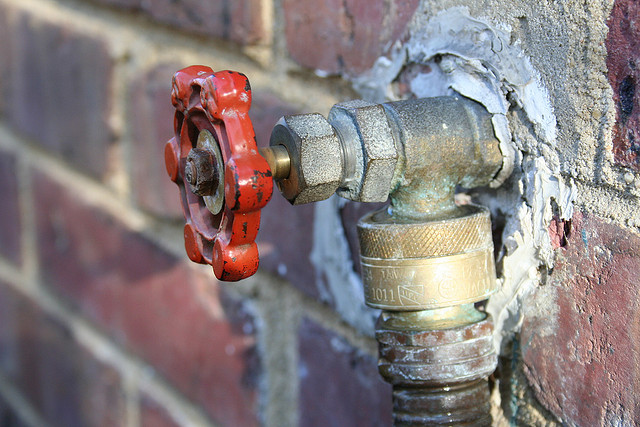Fall Maintenance: Freezeproof Faucets
If you live in an area with frosty winters, you know the agony of exploding pipes and the pain of preventive maintenance to stop the issue before it starts. Particularly cold cities tend to experience a high rate of plumbing calls in the winter (Minneapolis plumbing companies, for example, do a brisk business in the cold months) from panic-stricken homeowners. Don't let that be you!
The best home maintenance tasks are the kind that actually reduce your overall home maintenance. Installing a freezeproof faucet is a case in point. This faucet's function is no different from a standard sillcock (a.k.a hose bib, outdoor spigot), yet its clever design saves you having to turn off the water supply to the faucet and/or put on those silly insulated covers every fall, and you no longer have to worry about the faucet or its supply pipe freezing in winter. That's one summer-to-fall maintenance item you can permanently erase from your checklist. However, you still have to remove, drain and hang up your hoses.
How a Freezeproof Faucet Works
Also called "freezeless" or "frost-free" faucets, freezeproof faucets look like regular sillcocks on the outside (where the handle is), but have a long pipe on their back ends. This pipe extends 4 or more inches into the house -- where it's relatively warm in winter -- and connects to the water supply line.
The clever part is where the faucet's valve is located: On standard sillcocks, the valve is inside the main body, just behind or under the outdoor handle. On freezeproof faucets, the handle turns a long stem that runs inside the pipe going into the house. At the house end of the pipe is where the valve actually controls the water flow.
When you turn off the water at the handle outdoors, the water inside the pipe automatically drains (thanks to gravity) out through the spout, so there's no water left to freeze inside the pipe. Freezeproof faucets come in a range of lengths to accommodate different installation configurations as well as varying levels of protection (see "Are They Really Freezeproof?" below).
Most freezeproof faucets include an anti-siphon device (under a little plastic cap above the handle) that prevents contaminated liquids (old hose water, lawn chemicals, etc.) from being sucked back into the water supply. If the water flow from the city stops suddenly, it could create a vacuum that pulls the water the wrong way (not likely, but possible).
There are also freestanding freezeproof faucets for garden and greenhouse applications. These typically are called hydrants, and they use a similar system as house-mounted freezeproof faucets, except with hydrants the earth (not the house) provides the warmth to prevent freezing.
Installation Details
Not all houses have the same plumbing parts leading to the outdoor faucets, but most local building codes require a shutoff valve between the water supply line and the faucet. From there, you'll likely need a short length of pipe (sized to match the faucet pipe) and a female threaded fitting to join with the male threaded fitting that's standard on freezeproof faucets. If you have copper pipe, you may be able to use push-in fittings (such as SharkBite) to make the connections, which will avoid soldering; just be sure to follow local code. If you must solder near the faucet fitting, first remove the valve stem assembly because the heat can melt the rubber valve seat. With CPVC or PEX pipe, use the appropriate interface fittings to connect to the faucet. For galvanized pipe, you'll likely need a dielectric union to transition from the steel to copper to prevent corrosion caused by dissimilar pipe materials.
Apart from making watertight connections inside the house, the most important aspect of installing a freezeproof faucet is sloping the faucet slightly downward from the water line to the outdoor spout. This allows gravity to drain the water inside the faucet pipe each time the water is shut off. Without the slope, the pipe can remain filled with water and potentially freeze.
Not comfortable doing it yourself? Find a local handyman to help out.
Are They Really Freezeproof?
The short answer is: not always. But freezeproof faucets are reliable enough that they don't have to be called "freeze-resistant" or some other non-committal name that makes lawyers lose interest. Because they require above-freezing ambient air temperatures, the faucets can freeze if it's really cold and one or more of the following conditions exists:
1) the faucet pipe going into the house is too short, and therefore the valve (and the water behind it) is too close to the outside wall
2) the wall (or rim joist) is not sufficiently insulated
3) there's a big hole where the faucet pipe goes through the wall, letting in lots of cold air.
Fortunately, the solutions are just as simple: seal air gaps with spray foam sealant or caulk, insulate the rim joist or wall area near the faucet, and/or use a faucet with a longer pipe that reaches further into the house.
Philip Schmidt writes for Networx.com.
Updated February 21, 2018.
Looking for a Pro? Call us (866) 441-6648

Plumbing Average Costs
Plumbers Experiences

Garbage Disposal Replacement Just Before New Tenant Arrived

Gas Line Replacement By A Plumber Who Takes Pride In His Work




